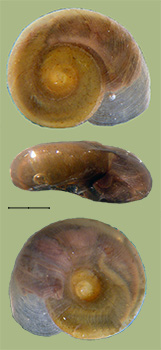> Habitat & Distribution
The
range of P.
umbilicatellus
extends from Alaska through the prairies of western Canada, south to
New Mexico and Oklahoma, and east to western New York (Burch,
1989). Populations typically inhabit temporary water bodies,
shallow margins of permanent bodies, and river pools (Clarke, 1981;
Cvancara, 1983; Narr and Krist 2020).
Specific historical
records of this species in the Great Plains include Kansas, Nebraska,
Wyoming, and Colorado (Leonard 1959, Hibbard and Taylor 1960, Taylor
1960, Beetle 1989, Wu 1989). This species was observed during a recent
survey in Wyoming (Narr and Krist 2019) but was not found in recent
surveys of Colorado (Harrold and Guralnick, 2010). We are
aware
of but a single population of P.
umbilicatellus in our four-state Great Plains study area,
inhabiting a slough in central North Dakota.
> Ecology & Life History
No life history data are available for P. umbilicatellus. Jokinen s (1987) analysis of the distribution of the biologically similar Promenetus exacuous in Connecticut and New York led her to classify it as a C-D tramp, potentially present in nearly every community. Dillon s (2000: 360-363) reanalysis of these data suggested that P. exacuous populations in the region seem to be Undifferentiated with respect to life history adaptation.
Life history studies of Promenetus exacuous populations in the American East suggest a semelparous life history, with two cohorts produced each year (McKillop 1985, Jokinen 1992). This is life cycle C of Dillon (2000:158).
> Taxonomy & Systematics
This species was originally described from Manitoba by J.W. Taylor (1885) as Planorbis umbilicatus. Taylor was especially stricken by the funnel-shaped shell umbilicus, which distinguished it from the much more common and widespread Gyraulus (Planorbis) parvus. The specific epithet umbilicatus was preoccupied by a European planorbid, however, and so Cockerell (1887) proposed umbilicatellus as a replacement. Baker (1935, 1945) split P. umbilicatellus and the (eastern) P. exacuous into a new genus Promenetus on the basis of a well developed subglobular penial gland.
The classification of the Planorbidae proposed by the tag team of Baker (1945) and Hubendick (1955) remains, after 50 years, the basis for our understanding of this large and diverse family of pulmonates worldwide. See the essay of 11Apr08 below.
> Maps and Supplementary Resources
> Essays
- See my post to the FWGNA blog of 11Apr08 for a review of the Classification of the Planorbidae.
- Or view the (Hubendick 1955) classification of North American planorbids in a tabular format [here].
> References
Baker, F. (1928) Freshwater
Mollusca of Wisconsin, Part I, Gastropoda. Bull. Wisc. Geol. Natur.
Hist. Survey, no. 70. University of Wisconsin Press, Madison.
Baker, F.C. 1935.The generic position of Planorbis umbilicatellus
with the description of a new group of Planorbidae. Nautilus 49: 46 48.
Baker, F.
(1945) The Molluscan Family Planorbidae. Urbana:
University of Illinois Press.
Baker, H. B. (1946)
Index to F.C. Baker's "The Molluscan Family Planorbidae." Nautilus, 59,
127-41.
Burch, J.B. (1989)
North American Freshwater Snails. Malacological Publications, Hamburg,
Michigan.
Clarke, A.H. (1979) Gastropods as indicators of trophic
lake stages. Nautilus 93:138-142.
Clarke, A.H.
(1981)
The Freshwater Molluscs of Canada. National Museum of Natural Sciences,
National Museums of Canada, Ottawa, Canada.
Cockerell, T.D.A. 1887.
[A letter to the] Editor The Conchologist's Exchange. The
Conchologist's Exchange. 2(5): 68.
Dillon, R.T., Jr. (2000)
The Ecology of Freshwater Molluscs. Cambridge University Press,
Cambridge, United Kingdom.
Hubendick, B.
(1955) Phylogeny in the Planorbidae.
Trans. Zool. Soc. London 28: 453-542.
Jokinen, E.H. (1983)
The
Freshwater Snails of Connecticut. State Geological and Natural History
Survey of Connecticut, Department of Environmental Protection Bulletin
109, Hartford, Connecticut.
Jokinen, E.H. (1987)
Structure
of freshwater snail communities: species-area relationships and
incidence categories. American Malacological Bulletin
5:9-19.
Jokinen, E.H. (1992)
The
Freshwater Snails (Mollusca: Gastropoda) of New York State. New York
State Museum Bulletin 482, Albany, New York.
McKillop, W.B. (1985)
Distribution of aquatic gastropods across the Ordovician dolomite
Precambrian granite contact in southeastern Manitoba, Canada.
Canadian Journal of Zoology 63:278-288.
Narr, C.F. and Krist,
A.C. 2019.
Improving estimates of richness, habitat associations, and assemblages
characteristics of freshwater gastropods. Aquatic Conservation Marine
Freshwater Ecosystems 30(1): 1 13.
Stewart, T.W. (2006)
The
freshwater gastropods of Iowa (1821-1998): species composition,
geographic distributions, and conservation concerns. American
Malacological Bulletin 21: 59 - 75.
Taylor, J.W. 1885.
Description of a new species of Planorbis
from Manitoba. Journal of Conchology Vol 4: 351.
Wu, S-K. 1989.
Colorado Freshwater Mollusks. Natural History Inventory of Colorado 11:
1 - 117. University of Colorado Museum, Boulder.








